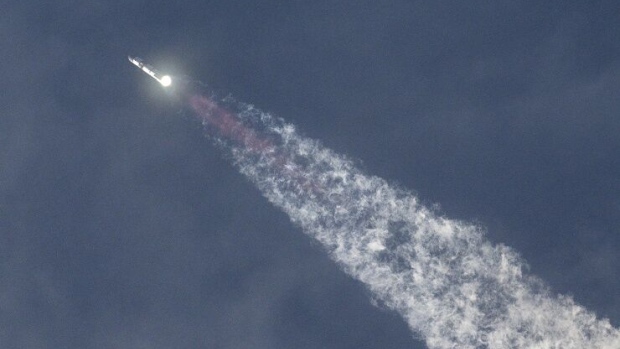Mar 14, 2024
Musk’s SpaceX Set to Launch Massive Rocket After Past Explosions
, Bloomberg News

(Bloomberg) -- SpaceX launched its Starship rocket into space in a critical test, sending the colossal craft farther and faster than it had ever flown, before it was lost while returning to Earth.
The mission, which featured several key demonstrations of the craft’s capabilities, lasted much longer than the past two attempts, which each ended quickly in explosions. The achievement brings the company a step closer to using Starship to launch satellites and eventually reaching Chief Executive Officer Elon Musk’s goal of ferrying humans to the moon and Mars.
Despite early concerns about possible high winds, Starship lifted off around 8:25 a.m. local time Thursday from the company’s Starbase launch site in Boca Chica, Texas. The craft then successfully separated from its Super Heavy booster as planned and reached near orbit.
Around 50 minutes into the mission, live footage streamed on Musk’s X social media platform showed Starship’s external hardware glowing bright red as it reentered Earth’s atmosphere, setting off a round of cheers and applause from SpaceX employees at its headquarters in Hawthorne, California. But shortly after, SpaceX said it lost signal connection with Starship and later confirmed the vehicle was “lost” — presumably breaking apart or burning up as it plummeted back to Earth — cutting the mission short.
During the flight, Starship — which Musk said was the largest flying object ever made — traveled just over 145 miles (234 km) high and reached speeds of up to 16,457 miles per hour, according to data shown during the webcast.
“We are making great strides through Artemis to return humanity to the Moon—then look onward to Mars,” NASA Administrator Bill Nelson said in an X post that referenced the space agency’s marquee moon mission.
Musk said recently he hopes SpaceX can attempt at least six more Starship launches this year.
The Federal Aviation Administration said on Thursday it would oversee a SpaceX-led investigation after an unspecified “mishap occurred” during the launch involving Starship and its booster. The agency, which has overseen similar investigations after each launch, said in a statement that no public injuries or public property damage was reported.
Standing 397 feet (121 meters) high, the Starship launch system is the largest and most powerful rocket ever developed, taller than the Saturn V that sent Neil Armstrong to the moon. The company already has a contract with NASA to carry people on Starship to the moon. Once fully operational, the craft will also be able to haul massive amounts of cargo and launch the company’s much larger Starlink internet satellites.
Each of the prior launches — the first in April 2023 and second in November — ended with Starship blowing up. The more recent flight lasted about eight minutes — just long enough to reach space but not reach orbital speeds. That was about twice as long as the first attempt, which significantly damaged the launchpad.
The closely held aerospace company, formally known as Space Exploration Technologies Corp., doesn’t typically view in-flight failures during a rocket’s development as major setbacks, but rather learning moments that help develop its vehicles further.
While Thursday’s mission appeared to be a significant improvement on prior tests, it wasn’t without some snags before the loss of the craft. SpaceX said the booster, which was supposed to have a soft splashdown in the Gulf of Mexico, came down harder than expected after seeming to lose control.
During the livestream of the flight, Starship’s camera appeared to show it rolling in space at various times. And during reentry, debris could be seen falling away from the spacecraft. SpaceX also skipped eagerly awaited plans to reignite Starship’s Raptor engines in space.
Company employees on the livestream said controllers had commanded Starship’s cargo bay door to open and close, which will be needed to deploy satellites in the future, and also attempted to transfer super cold propellant between tanks — a critical technical feat central to its ability to get to the moon. Webcast announcers and later NASA said a flight data review was needed to determine whether these tests were successful.
SpaceX still has a long way to go until people can take trips to deep space and other worlds. Those items include figuring out life support systems, how to refuel Starship in orbit and how to land the spacecraft in one piece.
--With assistance from Aashna Shah.
(Updates with details throughout.)
©2024 Bloomberg L.P.





